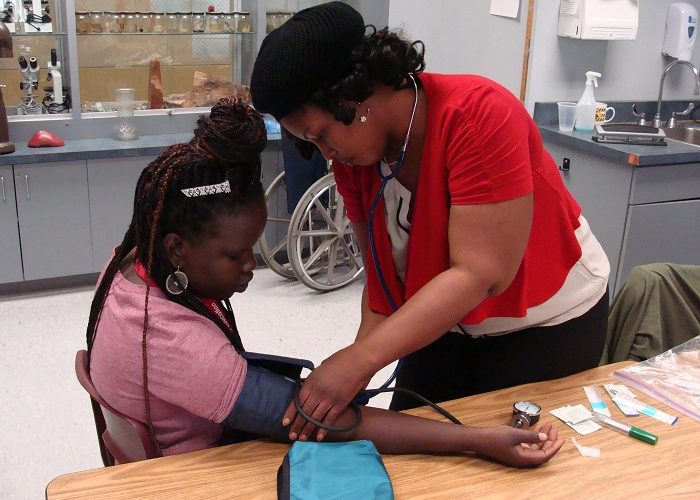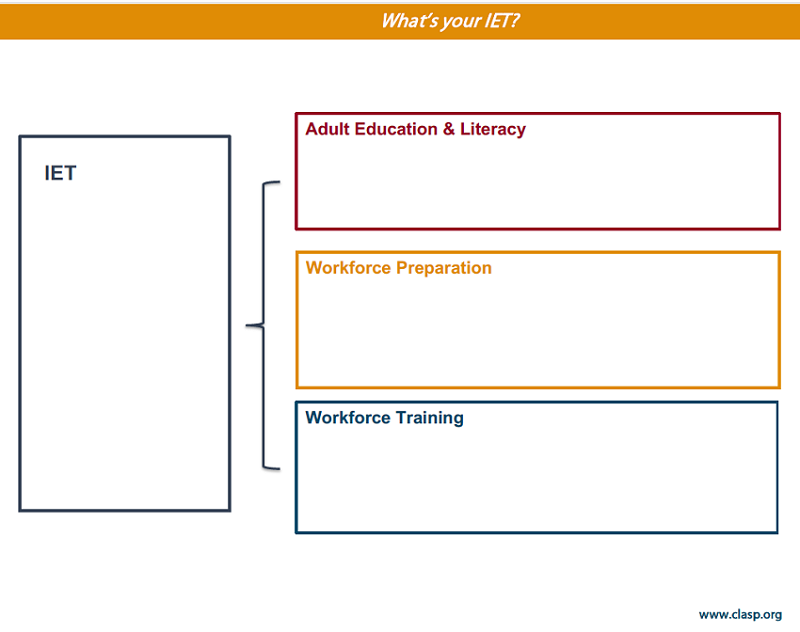- MN ABE Connect
- Archive
- Integrated Education & Training – Tools of the Trade!
 June 22, 2020
June 22, 2020
Integrated Education & Training – Tools of the Trade!
Liz Andress, Adult Career Pathways ConsultantIntegrated education and training (IET) is a proven approach to building effective adult career pathway programs. The ATLAS online Adult Career Pathways resource library provides great information, guidance and tools to assist MN ABE programs in building IET courses and defining an integrated single set of learning objectives.

CASAS National Summer Institute 2018
What is IET?
According to the Workforce Innovation & Opportunity Act (WIOA), “Integrated Education and Training (IET) is a service approach that provides (1) adult education and literacy activities concurrently and contextually with (2) workforce preparation activities and (3) workforce training for a specific occupation or occupational cluster for the purpose of educational and career advancement.” In Minnesota we have focused much of our professional development on developing career pathways. IET is a way to build career pathways to ensure that all aspects of the learning are integrated effectively.
What do the three components each mean? How are they implemented in various contexts?
Judy Mortrude (formerly a Minnesota ABE leader), while at the Center for Law & Social Policy, provided some of the clearest guidance for understanding and implementing IETs. IET: Building Career Pathways for Participants at Every Skill Level, is a 14-page article that includes a one-page summary of the WIOA definition of each component – adult education and literacy, workforce preparation and workforce training – in a clear diagram format. Mortrude follows this with seven diverse examples of IET programs from around the country, including manufacturing, computer technician, commercial driver, and others. In addition, the article clarifies how the components align with standards and provides a diagram template for planning the three components of your own IET. You can access similar information in a one-hour webinar recording.

CLASP, March 2018
What can I learn from ABE programs that have implemented IET around the country?
An engaging Q&A format is used in the article IET: Implementing Programs in Diverse Contexts. You get to “meet” colleagues from Rhode Island to Kansas to Texas as they respond to a variety of questions based on their IET implementation experiences:
- How did partners work together to develop an integrated, contextualized curriculum?
- How do you intake and onboard students?
- What does team teaching look like in your courses?
- How did you assess the effectiveness of the IET?
- How did you fund the IET work?
- … and more
How do we create a single set of learning objectives?
For an IET to be integrated, there must be a single set of learning objectives that incorporate all three components of the IET – adult education and literacy, workforce preparation and workforce training. Developing a Single Set of Learning Objectives for IET is a very helpful 75-minute webinar that guides you step-by-step through this process of creating your IET objectives. The same link provides access to a simple chart template that can help your IET instructors clearly define objectives.
What are best practices for “co-teaching” in an IET?
Whether it’s called co-teaching, team teaching or integrated instruction, working with another instructor in the classroom is often a new and challenging experience for an ABE instructor. A set of nine videos (ranging from 3 to 44 minutes in length) provide glimpses of integrated instruction in action, as well as reflections and advice from educators. Parallel, split-differentiated, complementary and monitoring are four of the various approaches to co-teaching that you’ll see.
It’s all worth it!
Participants in quality IET programs tell us again and again – in words and in actions – that when their language and literacy learning is linked directly and immediately to their workforce training and career goals, they are engaged and motivated! Having a relevant purpose and clear goals in instruction reflects best practices in adult teaching and learning. Utilize these easy-to-access resources to build integrated education and training programs that move learners into livable wage jobs, equipped for success.
Newsletter Signup
Get MN ABE Connect—the official source for ABE events, activities, and resources!
Sign UpArticle Categories
- ABE Foundations/Staff Onboarding
- ACES/Transitions
- Adult Career Pathways
- Assessment
- CCR Standards
- Citizenship
- COVID-19
- Cultural Competency
- Digital Literacy/Northstar
- Disabilities
- Distance Learning/Education
- ELA
- Equity/Inclusion
- ESL
- HSE/Adult Diploma
- Listening
- Math/Numeracy
- Mental Health
- Minnesota ABE
- One-Room Schoolhouse/Multilevel
- Professional Development
- Program Management
- Reading
- Remote Instruction
- Science
- Social Studies
- Speaking/Conversation
- Support Services
- Teaching Strategies
- Technology
- Uncategorized
- Volunteers/Tutors
- Writing